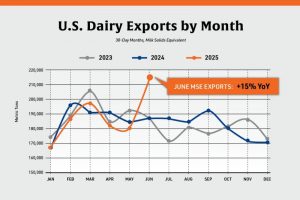
So what does the future of milk pricing look like? No one knows for sure, and nearly everyone with skin in the game has an idea.
But if there was a consistent message that came out of a recent online meeting put on by the American Dairy Coalition, it was that change is needed in the way farm-level milk is priced.
More than 160 listeners tuned in to the meeting, including a few farmers who talked specifically about their ideas. One farmer called for reforming the way advanced and component pricing is calculated, stating that the current system does not correctly value Class I fluid milk.
Arden Tewksberry, a longtime dairy farmer from Meshoppen, Pa., said that a supply management program and a system that establishes a price based on the farmers’ cost of production is needed.
Ray Diederich, a dairy farmer from Wisconsin, said the way to a simpler price is by better price discovery. He argued that milk shouldn’t be allowed to be depooled from the federal orders, and that a system that better reflects the amount consumers are willing to pay for milk, not government intervention, is needed.
Kim Bremmer of the Venture Dairy Cooperative in Wisconsin said more farmer voices are needed. She said farmers don’t have a good enough way to speak up, and that there is a sense by many in the community that speaking up will result in retribution by a processor or cooperative.
Understanding the orders
But making changes to the way milk is priced, especially the Federal Milk Marketing Order (FMMO) system, is not easy, and it requires a little bit of background.
Calvin Covington, retired CEO of the Southeast Milk Cooperative, said the development of the system, which goes back to the 1937 Ag Marketing Agreement Act, was never meant to require dairy farmers to participate. It has always been voluntary, not mandatory.
For example, the Western Order that covered Idaho dairy producers and surrounding states was terminated in 2004. California, on the other hand, elected to join the federal system in 2018 after decades with its own state system.
The system has undergone many changes. There are 11 orders right now, but there were up to 80 milk orders in the 1960s. Covington explained that processing plants have gotten larger, encompass much bigger areas and take milk from very large geographic areas, sometimes across state boundaries.
Fluid milk plants in federal orders are required to pool their milk. Covington said this is to ensure the federal order system’s primary purpose — to provide an adequate supply of fluid milk for a region — is being met.
But consumer preferences are changing.
“We’ve gone from drinking our milk to eating our milk,” Covington said, noting the rise in cheese and other dairy-derived products.
Last year, only 20% of milk went to fluid use, he said, and 137 billion pounds of milk was pooled, about 60% of the nation’s milk production. This is largely because a lot of milk got depooled, especially in the Upper Midwest, since non-fluid milk plants are not required to participate in the FMMO system.
When Class III prices are higher than the other classes, like Class I fluid, staying in the FMMO pool doesn’t benefit non-fluid processors because they have to pay the higher Class III price for their milk. This results in depooling, which lowers the overall value of the pool and the uniform price paid to all farmers in it. Class III cheese processors will often pay their producers the uniform price, or even a little more, and can keep the rest instead of pooling it.
Depooling was one of the key factors that led to the historic negative producer price differentials (PPDs) producers saw taken from their milk checks in 2020.
But Covington said the FMMO system provides important services that producers often overlook. One important one is payment terms — that is, setting the dates that producers must be paid.
“I can’t emphasize enough how important the payment terms are,” he said.
Federal orders also audit regulated plants, provide market information and marketing services, and even some labs for testing. They even provided producer payroll services in the past.
Modifying the federal order system can involve several forms of rule-making, like an administrative hearing process, legislation, and informal rule-making that involves a notice and comment period.
The 1995 Farm Bill, which called for federal order reform, is an example of legislation and informal rule-making, Covington said. He recalled that process as being an intense, multiyear process that took four years, but he noted that it gave producers the chance to be involved and have their voices heard.
Simple to understand, more competition
Mike McCully, of the Indiana-based McCully Group LLC and a member of the International Dairy Foods Association dairy ingredients board, said the pricing system should be reformed to let milk flow to the highest value via competition, not rigid government formulas.
He said that milk pricing should be simplified, and he argued for a dairy policy that fosters innovation and export competitiveness.
McCully said that milk used for exports has exceeded fluid milk utilization in recent months, which is a big change since the federal order system was set up to regulate local milk, not global milk.
So what are his ideas for reform? Doing away with regulated minimum pricing, phasing out Class 1 differentials, additional and more frequent marketing reports, and better enforcement of payments and contracts.
“The basis of this system is Class I is the highest-value use. I argue adamantly that that is not the case anymore,” McCully said. “Maybe it works in a couple of different spots, but not nationally.”
Coming up with a consensus has been difficult for many years, and this lack of consensus is a big reason why Secretary of Agriculture Tom Vilsack has stated that USDA would not hold Federal Milk Marketing Order hearings until a consensus on milk pricing reform is reached.
Still, Laurie Fischer, CEO of the American Dairy Coalition, said farmers should be heard.
“I think that farmers have a lot of expertise of where this goes in the future, and we want to have them at the table,” she said.
Frank Doll, a member of the Prairie Farms Cooperative and a third-generation producer in Illinois, has a simple request.
“I’m just a farmer. I’d like to read my milk check and understand it quickly,” he said.























